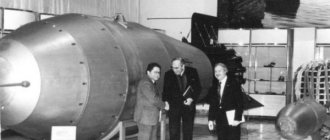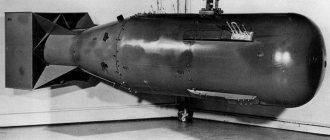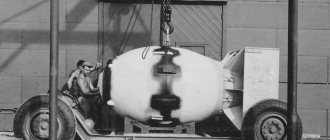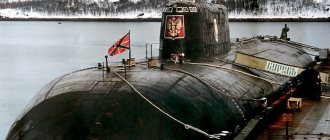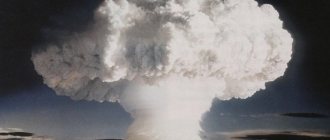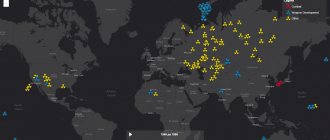The explosion occurred in 1961. Within a radius of several hundred kilometers from the test site, a hasty evacuation of people took place, as scientists calculated that all houses without exception would be destroyed. But no one expected such an effect. The blast wave circled the planet three times. The landfill remained a “blank slate”; all the hills on it disappeared. Buildings turned to sand in a second. A terrible explosion was heard within a radius of 800 kilometers.
If you think that the atomic warhead is the most terrible weapon of mankind, then you do not yet know about the hydrogen bomb. We decided to correct this oversight and talk about what it is. We have already talked about the number of nuclear warheads in countries around the world and the number of nuclear warheads in Russia.
A little history
There, beyond the ocean
As you know, Americans are the most enterprising people in the world. They have a great flair for everything new. Therefore, one should not be surprised that the first atomic bomb appeared in this part of the world. Let's give a little historical background.
- The first stage on the path to the creation of an atomic bomb can be considered the experiment of two German scientists O. Hahn and F. Strassmann to split the uranium atom into two parts. This, so to speak, still unconscious step was taken in 1938.
- French Nobel laureate F. Joliot-Curie proved in 1939 that atomic fission leads to a chain reaction accompanied by a powerful release of energy.
- The genius of theoretical physics A. Einstein put his signature on a letter (in 1939) addressed to the President of the United States, the initiator of which was another atomic physicist L. Szilard. As a result, even before the start of World War II, the United States decided to begin developing atomic weapons.
- The first test of the new weapon was carried out on July 16, 1945 in northern New Mexico.
- Less than a month later, two atomic bombs were dropped on the Japanese cities of Hiroshima and Nagasaki (August 6 and 9, 1945). Humanity had entered a new era - now it was capable of destroying itself in a few hours.
The Americans fell into real euphoria from the results of the total and lightning destruction of peaceful cities. Staff theorists of the US Armed Forces immediately began to draw up grandiose plans consisting in completely erasing 1/6 of the world - the Soviet Union - from the face of the Earth.
Caught up and overtook
The Soviet Union also did not sit idly by. True, there was some lag caused by the resolution of more urgent matters - the Second World War was going on, the main burden of which lay on the country of the Soviets. However, the Americans did not wear the leader's yellow jersey for long. Already on August 29, 1949, at a test site near the city of Semipalatinsk, a Soviet-style atomic charge was tested for the first time, created at the right time by Russian nuclear scientists under the leadership of Academician Kurchatov.
And while the frustrated “hawks” from the Pentagon were revising their ambitious plans to destroy the “stronghold of the world revolution,” the Kremlin launched a preemptive strike - in 1953, on August 12, tests of a new type of nuclear weapon were carried out. There, in the area of Semipalatinsk, the world's first hydrogen bomb, codenamed “Product RDS-6s”, was detonated. This event caused real hysteria and panic not only on Capitol Hill, but also in all 50 states of the “stronghold of world democracy.” Why? What is the difference between an atomic bomb and a hydrogen bomb that horrified the world's superpower? We will answer immediately. The hydrogen bomb is much more powerful than the atomic bomb. Moreover, it costs significantly less than an equivalent atomic sample. Let's look at these differences in more detail.
Which bomb is more powerful?
The power of a thermonuclear bomb can be hundreds of thousands of times greater than that of an atomic bomb. The explosive force of an atomic bomb is calculated in kilotons (1 kiloton = 1000 tons of TNT). The unit of measurement for the power of a thermonuclear bomb is the megaton, or 1,000,000 tons of TNT.
Clouds of death: nuclear weapons testing in photographs
The first nuclear bomb test in history was the explosion of the Thing as part of the Manhattan Project. On July 16, 1945, the American military tested an implosion-type plutonium bomb at the Alamogordo test site. The power of the explosion was 21 kilotons of TNT. Less than a month later, the Fat Man bomb, built to the same type as the Thing, was dropped on Nagasaki. In the photo: the explosion of the “Thing” 16 milliseconds after detonation. Commons.wikimedia.org
The first Soviet tests of atomic weapons took place after the Second World War. In August 1949, RDS-1, a 22-kiloton atomic bomb weighing 4.6 tons, was detonated at the Sempialata test site. The explosion completely destroyed the 37-meter tower on which the bomb was installed, and a crater with a diameter of three meters and a depth of one and a half meters formed around it. Ten Pobeda vehicles were installed at a distance of a kilometer from the epicenter of the explosion, with a difference of 500 meters - each of them was completely burned out. Commons.wikimedia.org
In October 1952, Great Britain conducted its first nuclear tests. A 25-kiloton bomb was detonated aboard a frigate off Australia's Monte Bello Islands. The explosion completely destroyed the ship, some parts of which were vaporized by the energy of the explosion. Splashes of molten metal caused fires on nearby islands, and a crater six meters deep formed in the seabed. The explosion cloud reached a height of three kilometers. Commons.wikimedia.org
Less than a month has passed since the United States conducted the first-ever tests of a thermonuclear device. True, the Ivy Mike bomb was not originally intended for military purposes and was built only to experimentally test the “two-stage” bomb design. The explosion completely destroyed a group of small islands of Elugelab and caused severe contamination of the area, and the neutron flux at the time of the outbreak provoked the appearance of radioactive einsteinium and fermium. Commons.wikimedia.org
Two weeks later, the Americans staged an even more powerful explosion. The Eevee King bomb was tested near Enewetak Atoll in the Pacific Ocean. The cloud after detonation rose to a height of 22 kilometers. After the tests, the lead designer of the Evie King, Ted Taylor, became an active promoter of nuclear disarmament. Commons.wikimedia.org
In response to these tests, in 1953, at a test site near Semipalatinsk, Soviet scientists detonated the RDS-6s bomb, the first hydrogen bomb in the USSR. The explosion destroyed all brick buildings within a radius of four kilometers, and a railway bridge with a hundred-ton span was thrown 200 meters. The power of the explosion was 400 kilotons, which is 20 times higher than the energy release of the first atomic bomb. Commons.wikimedia.org
The Americans conducted their last nuclear tests in 1954 in the Marshall Islands. The energy release of the Castle Bravo bomb was 15 megatons, two and a half times higher than the calculated data. Within a minute, the mushroom cloud reached an altitude of 15 kilometers, and five minutes later it was already at an altitude of 40 km. After the explosion, craters formed in some areas of the seabed; NASA telescopes photographed them from space. It was the most powerful explosion in US history. Commons.wikimedia.org
A year later, Soviet scientists refined the bomb's design, and the RDS-37, a two-stage thermonuclear bomb, was born. The power of the explosion was 1.6 megatons - it was the first explosion in the history of the USSR, the energy release of which exceeded one megaton. The shock wave destroyed buildings at the test site and destroyed several residential buildings in Semipalatinsk, which led to the death of two people, including a three-year-old girl. A total of 26 people were injured from shrapnel and debris. Commons.wikimedia.org
In 1957, the British also prepared a thermonuclear bomb. The explosion power of the Grapple X bomb exceeded the energy release of the RDS-37, reaching 1.8 megatons. These tests, which became the first success of the British in the field of military application of thermonuclear fusion, turned Great Britain into a nuclear power as powerful as the USA and the USSR. Commons.wikimedia.org
By the 60s, nuclear weapons had reached a fundamentally new level - after testing the Tsar Bomba, Soviet scientists realized that they now had technologies capable of destroying the entire planet. After the tests, it became clear that the military, in fact, possesses weapons of mass destruction of unlimited power. The power of the explosion was, according to various sources, 57-59 kilotons, exceeding the calculated one (51.5). The energy released in 39 nanoseconds was approximately 1% of the energy released by the Sun; the fireball after the explosion could have reached the size of the Earth, but this was prevented by the shock wave that went around the planet and according to Commons.wikimedia.org
What is an atomic bomb?
The principle of operation of an atomic bomb is based on the use of energy resulting from an increasing chain reaction caused by the fission (splitting) of heavy nuclei of plutonium or uranium-235 with the subsequent formation of lighter nuclei.
The process itself is called single-phase, and it proceeds as follows:
- After the charge detonates, the substance inside the bomb (isotopes of uranium or plutonium) enters the decay stage and begins to capture neutrons.
- The process of decay is growing like an avalanche. The splitting of one atom leads to the decay of several. A chain reaction occurs, leading to the destruction of all the atoms in the bomb.
- A nuclear reaction begins. The entire bomb charge turns into a single whole, and its mass passes its critical mark. Moreover, all this bacchanalia does not last very long and is accompanied by the instant release of a huge amount of energy, which ultimately leads to a grand explosion.
By the way, this feature of a single-phase atomic charge - quickly gaining a critical mass - does not allow an infinite increase in the power of this type of ammunition. The charge can be hundreds of kilotons in power, but the closer it is to the megaton level, the less effective it is. It simply will not have time to completely split: an explosion will occur and part of the charge will remain unused - it will be scattered by the explosion. This problem was solved in the next type of atomic weapon - a hydrogen bomb, which is also called a thermonuclear bomb.
Working principle and advantages of a vacuum bomb
It is believed that a vacuum bomb, created using the latest technologies, can compete with a nuclear one. The fact is that instead of TNT, a gas substance is used here, which is several tens of times more powerful. The high-power aircraft bomb is the most powerful vacuum bomb in the world, which is not a nuclear weapon. It can destroy the enemy, but houses and equipment will not be damaged, and there will be no decay products.
What is the principle of its operation? Immediately after being dropped from the bomber, a detonator is activated at some distance from the ground. The body is destroyed and a huge cloud is sprayed. When mixed with oxygen, it begins to penetrate anywhere - into houses, bunkers, shelters. The burning out of oxygen creates a vacuum everywhere. When this bomb is dropped, a supersonic wave is produced and a very high temperature is generated.
What is a hydrogen bomb?
In a hydrogen bomb, a slightly different process of energy release occurs. It is based on working with hydrogen isotopes - deuterium (heavy hydrogen) and tritium. The process itself is divided into two parts or, as they say, is two-phase.
- The first phase is when the main energy supplier is the fission reaction of heavy lithium deuteride nuclei into helium and tritium.
- The second phase - thermonuclear fusion based on helium and tritium is launched, which leads to instant heating inside the warhead and, as a result, causes a powerful explosion.
Thanks to the two-phase system, the thermonuclear charge can be of any power.
Note. The description of the processes occurring in an atomic and hydrogen bomb is far from complete and the most primitive. It is provided only to provide a general understanding of the differences between these two weapons.
The danger of nuclear war
Even in the middle of the last century, the danger of nuclear war was unlikely. Two countries had atomic weapons in their arsenal: the USSR and the USA. The leaders of the two superpowers were well aware of the danger of using weapons of mass destruction, and the arms race was most likely conducted as a “competitive” confrontation.
Of course, there were tense moments in relation to the powers, but common sense always prevailed over ambitions.
The situation changed at the end of the 20th century. The “nuclear baton” was taken over not only by the developed countries of Western Europe, but also by representatives of Asia.
| A country | Number of warheads (units) | Last test (year) |
| USA | 5113 | 1992 |
| Russia | 2825 | 1990 |
| France | >300 | 1995 |
| Great Britain | >230 | 1991 |
| China | >200 | 1996 |
| India | 80-90 | 1996 |
| Pakistan | 70 | 1998 |
| North Korea | 10 | 2015 |
But, as you probably know, the “ nuclear club
"consists of 10 countries. It is unofficially believed that Israel, and possibly Iran, have nuclear warheads. Although the latter, after the imposition of economic sanctions on them, abandoned the development of the nuclear program.
Comparison
What's in the bottom line?
Any schoolchild knows about the damaging factors of an atomic explosion:
- light radiation;
- shock wave;
- electromagnetic pulse (EMP);
- penetrating radiation;
- radioactive contamination.
The same can be said about a thermonuclear explosion. But!!! The power and consequences of a thermonuclear explosion are much stronger than an atomic one. Let us give two well-known examples.
“Baby”: black humor or cynicism of Uncle Sam?
The atomic bomb (codenamed “Little Boy”) dropped on Hiroshima by the Americans is still considered the “benchmark” for atomic charges. Its power was approximately 13 to 18 kilotons, and the explosion was ideal in all respects. Later, more powerful charges were tested more than once, but not much (20-23 kilotons). However, they showed results that were little higher than the achievements of “Kid”, and then stopped altogether. A cheaper and stronger “hydrogen sister” appeared, and there was no longer any point in improving atomic charges. This is what happened “at the exit” after the explosion of “Malysh”:
- The nuclear mushroom reached a height of 12 km, the diameter of the “cap” was about 5 km.
- The instantaneous release of energy during a nuclear reaction caused a temperature at the epicenter of the explosion of 4000 ° C.
- Fireball: diameter about 300 meters.
- The shock wave knocked out glass at a distance of up to 19 km, and was felt much further.
- About 140 thousand people died at once.
Queen of all queens
The consequences of the explosion of the most powerful hydrogen bomb tested to date, the so-called Tsar Bomb (code name AN602), exceeded all previous explosions of atomic charges (not thermonuclear ones) combined. The bomb was Soviet, with a yield of 50 megatons. Its tests were carried out on October 30, 1961 in the Novaya Zemlya region.
- The nuclear mushroom grew 67 km in height and the diameter of the upper “cap” was approximately 95 km.
- The light radiation hit a distance of up to 100 km, causing third-degree burns.
- The ball of fire, or ball, grew to 4.6 km (radius).
- The sound wave was recorded at a distance of 800 km.
- The seismic wave circled the planet three times.
- The shock wave was felt at a distance of up to 1000 km.
- The electromagnetic pulse created powerful interference for 40 minutes several hundred kilometers from the epicenter of the explosion.
One can only imagine what would have happened to Hiroshima if such a monster had been dropped on it. Most likely, not only the city, but also the Land of the Rising Sun itself would disappear. Well, now let’s bring everything that we have said to a common denominator, that is, we will draw up a comparative table.
Clouds of death: nuclear weapons testing in photographs
The first nuclear bomb test in history was the explosion of the Thing as part of the Manhattan Project. On July 16, 1945, the American military tested an implosion-type plutonium bomb at the Alamogordo test site. The power of the explosion was 21 kilotons of TNT. Less than a month later, the Fat Man bomb, built to the same type as the Thing, was dropped on Nagasaki. In the photo: the explosion of the “Thing” 16 milliseconds after detonation. Commons.wikimedia.org
The first Soviet tests of atomic weapons took place after the Second World War. In August 1949, RDS-1, a 22-kiloton atomic bomb weighing 4.6 tons, was detonated at the Sempialata test site. The explosion completely destroyed the 37-meter tower on which the bomb was installed, and a crater with a diameter of three meters and a depth of one and a half meters formed around it. Ten Pobeda vehicles were installed at a distance of a kilometer from the epicenter of the explosion, with a difference of 500 meters - each of them was completely burned out. Commons.wikimedia.org
In October 1952, Great Britain conducted its first nuclear tests. A 25-kiloton bomb was detonated aboard a frigate off Australia's Monte Bello Islands. The explosion completely destroyed the ship, some parts of which were vaporized by the energy of the explosion. Splashes of molten metal caused fires on nearby islands, and a crater six meters deep formed in the seabed. The explosion cloud reached a height of three kilometers. Commons.wikimedia.org
Less than a month has passed since the United States conducted the first-ever tests of a thermonuclear device. True, the Ivy Mike bomb was not originally intended for military purposes and was built only to experimentally test the “two-stage” bomb design. The explosion completely destroyed a group of small islands of Elugelab and caused severe contamination of the area, and the neutron flux at the time of the outbreak provoked the appearance of radioactive einsteinium and fermium. Commons.wikimedia.org
Two weeks later, the Americans staged an even more powerful explosion. The Eevee King bomb was tested near Enewetak Atoll in the Pacific Ocean. The cloud after detonation rose to a height of 22 kilometers. After the tests, the lead designer of the Evie King, Ted Taylor, became an active promoter of nuclear disarmament. Commons.wikimedia.org
In response to these tests, in 1953, at a test site near Semipalatinsk, Soviet scientists detonated the RDS-6s bomb, the first hydrogen bomb in the USSR. The explosion destroyed all brick buildings within a radius of four kilometers, and a railway bridge with a hundred-ton span was thrown 200 meters. The power of the explosion was 400 kilotons, which is 20 times higher than the energy release of the first atomic bomb. Commons.wikimedia.org
The Americans conducted their last nuclear tests in 1954 in the Marshall Islands. The energy release of the Castle Bravo bomb was 15 megatons, two and a half times higher than the calculated data. Within a minute, the mushroom cloud reached an altitude of 15 kilometers, and five minutes later it was already at an altitude of 40 km. After the explosion, craters formed in some areas of the seabed; NASA telescopes photographed them from space. It was the most powerful explosion in US history. Commons.wikimedia.org
A year later, Soviet scientists refined the bomb's design, and the RDS-37, a two-stage thermonuclear bomb, was born. The power of the explosion was 1.6 megatons - it was the first explosion in the history of the USSR, the energy release of which exceeded one megaton. The shock wave destroyed buildings at the test site and destroyed several residential buildings in Semipalatinsk, which led to the death of two people, including a three-year-old girl. A total of 26 people were injured from shrapnel and debris. Commons.wikimedia.org
In 1957, the British also prepared a thermonuclear bomb. The explosion power of the Grapple X bomb exceeded the energy release of the RDS-37, reaching 1.8 megatons. These tests, which became the first success of the British in the field of military application of thermonuclear fusion, turned Great Britain into a nuclear power as powerful as the USA and the USSR. Commons.wikimedia.org
By the 60s, nuclear weapons had reached a fundamentally new level - after testing the Tsar Bomba, Soviet scientists realized that they now had technologies capable of destroying the entire planet. After the tests, it became clear that the military, in fact, possesses weapons of mass destruction of unlimited power. The power of the explosion was, according to various sources, 57-59 kilotons, exceeding the calculated one (51.5). The energy released in 39 nanoseconds was approximately 1% of the energy released by the Sun; the fireball after the explosion could have reached the size of the Earth, but this was prevented by the shock wave that went around the planet and according to Commons.wikimedia.org
(Based on materials from the Great Encyclopedia of Technology and the website https://militaryarms.ru)
Table
| Atomic bomb | H-bomb |
| The principle of operation of the bomb is based on the fission of uranium and plutonium nuclei, causing a progressive chain reaction, resulting in a powerful release of energy leading to an explosion. This process is called single-phase, or single-stage | The nuclear reaction follows a two-stage (two-phase) scheme and is based on hydrogen isotopes. First, the fission of heavy lithium deuteride nuclei occurs, then, without waiting for the end of fission, thermonuclear fusion begins with the participation of the resulting elements. Both processes are accompanied by a colossal release of energy and ultimately end in an explosion |
| Due to certain physical reasons (see above), the maximum power of an atomic charge fluctuates within 1 megaton | The power of a thermonuclear charge is almost unlimited. The more source material, the stronger the explosion will be |
| The process of creating an atomic charge is quite complicated and expensive. | The hydrogen bomb is much easier to manufacture and less expensive |
So, we found out what the difference is between an atomic and a hydrogen bomb. Unfortunately, our little analysis only confirmed the thesis expressed at the beginning of the article: progress associated with the war took a disastrous path. Humanity has come to the brink of self-destruction. All that remains is to press the button. But let's not end the article on such a tragic note. We really hope that reason and the instinct of self-preservation will ultimately win and a peaceful future awaits us.
The difference between an American vacuum bomb and a Russian one
The differences are that the latter can destroy an enemy even in a bunker using the appropriate warhead. During an explosion in the air, the warhead falls and hits the ground hard, burrowing to a depth of 30 meters. After the explosion, a cloud is formed, which, increasing in size, can penetrate into shelters and explode there. American warheads are filled with ordinary TNT, so they destroy buildings. A vacuum bomb destroys a specific object because it has a smaller radius. It doesn’t matter which bomb is the most powerful - any of them delivers an incomparable destructive blow that affects all living things.
Consequences of the explosion
The result of a hydrogen bomb explosion is threefold. The very first thing that happens is a powerful blast wave. Its power depends on the height of the explosion and the type of terrain, as well as the degree of air transparency. Large firestorms can form that do not subside for several hours. And yet, the secondary and most dangerous consequence that the most powerful thermonuclear bomb can cause is radioactive radiation and contamination of the surrounding area for a long time.
Thermonuclear bomb "Kuzka's mother". Creation
The AN 602 bomb received several names - “Tsar Bomba” and “Kuzka’s Mother”. It was developed in the Soviet Union in 1954-1961. It had the most powerful explosive device in the entire existence of mankind. Work on its creation was carried out over several years in a highly classified laboratory called “Arzamas-16”. A hydrogen bomb with a yield of 100 megatons is 10 thousand times more powerful than the bomb dropped on Hiroshima.
Its explosion is capable of wiping Moscow off the face of the earth in a matter of seconds. The city center could easily evaporate in the literal sense of the word, and everything else could turn into tiny rubble. The most powerful bomb in the world would wipe out New York and all its skyscrapers. It would leave behind a twenty-kilometer-long molten smooth crater. With such an explosion, it would not have been possible to escape by going down to the subway. The entire territory within a radius of 700 kilometers would be destroyed and infected with radioactive particles.

